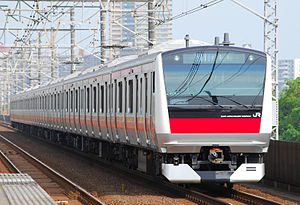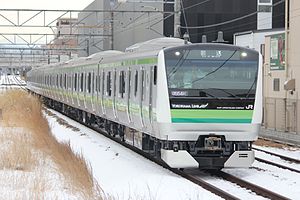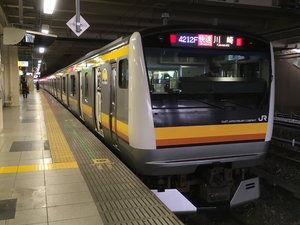E233-5000 series
| E233 series | |
|---|---|

A line-up of six different E233 series variants in October 2015 (left to right: Nambu Line E233-8000, Saikyo Line E233-7000, Yokohama Line E233-6000, Keiyo Line E233-5000, Takasaki Line E233-3000, Chuo Line E233-0 series)
|
|
| Manufacturer | JR East, Kawasaki Heavy Industries, Tokyu Car Corporation, J-TREC |
| Replaced | 201 series, 203 series, 205 series, 207-900 series, 209 series |
| Constructed | 2006–Present |
| Entered service | December 2006 |
| Number in service | 3,197 vehicles (as of 1 October 2016[update]) |
| Number scrapped | 7 cars (accident damage) |
| Formation | 4/5/6/8/10 cars per trainset |
| Operator(s) | JR East |
| Depot(s) | Kamakura, Kawagoe, Keiyo, Kōzu, Matsudo, Oyama, Toyoda, Saitama |
| Line(s) served | Chuo Line (Rapid), Keihin-Tohoku Line, Negishi Line, Tokaido Main Line, Joban Line, Tokyo Metro Chiyoda Line, Odakyu Line, Keiyo Line, Takasaki Line, Ryomo Line, Utsunomiya Line, Saikyo Line, Kawagoe Line, Rinkai Line, Yokohama Line, Nambu Line |
| Specifications | |
| Car body construction | Stainless steel |
| Car length | 20,000 mm (65 ft 7 in) |
| Width | 2,950 mm (9 ft 8 in) |
| Doors | 4 pairs per side |
| Maximum speed | 120 km/h (75 mph) |
| Traction system | IGBT-VVVF |
| Acceleration | 3.0 km/(h⋅s) (1.9 mph/s) |
| Deceleration | 5.2 km/(h⋅s) (3.2 mph/s) (emergency brake) |
| Electric system(s) | 1,500 V DC overhead catenary |
| Braking system(s) | Regenerative brake |
| Safety system(s) | ATS-P, ATS-SN, ATC, Digital ATC |
| Coupling system | Shibata-Type |
| Track gauge | 1,067 mm (3 ft 6 in) |
| E233-0 series | |
|---|---|

Chuo Line 10-car set T19 in August 2009
|
|
| Manufacturer | JR East Niitsu, Kawasaki Heavy Industries, Tokyu Car |
| Replaced | 201 series |
| Constructed | 2006–2008 |
| Entered service | 26 December 2006 |
| Number built | 693 vehicles |
| Number in service | 682 vehicles (94 sets) |
| Number scrapped | 5 vehicles (accident damage) |
| Formation | 4/6/10 cars per trainset |
| Operator(s) | JR East |
| Depot(s) | Toyoda |
| Line(s) served | Chuo Line (Rapid), Itsukaichi Line, Ome Line, Hachiko Line, Fuji Kyuko Line |
| Specifications | |
| Car body construction | Stainless steel |
| Car length | 20,000 mm (65 ft 7 in) |
| Width | 2,950 mm (9 ft 8 in) |
| Height | 3,620 mm (11 ft 11 in) |
| Floor height | 1,130 mm (3 ft 8 in) |
| Doors | 4 pairs per side |
| Traction system | MT75 traction motors |
| Electric system(s) | 1,500 V DC overhead catenary |
| Current collection method | PS33D pantograph |
| Bogies | DT71 (motor), TR255 (trailer) |
| Track gauge | 1,067 mm (3 ft 6 in) |
| E233-1000 series | |
|---|---|

Keihin-Tohoku Line E233-1000 series set 108 in March 2009
|
|
| Manufacturer | JR East Niitsu, Kawasaki Heavy Industries, Tokyu Car |
| Replaced | 209 series |
| Constructed | 2007–2010 |
| Entered service | 22 December 2007 |
| Number built | 830 vehicles (83 sets) |
| Number in service | 830 vehicles (83 sets) |
| Number scrapped | 2 cars |
| Formation | 10 cars per trainset |
| Fleet numbers | 101–183 |
| Operator(s) | JR East |
| Depot(s) | Saitama |
| Line(s) served | Keihin-Tohoku Line, Negishi Line |
| Specifications | |
| Car body construction | Stainless steel |
| Car length | 20,000 mm (65 ft 7 in) |
| Width | 2,950 mm (9 ft 8 in) |
| Height | 3,620 mm (11 ft 11 in) |
| Floor height | 1,130 mm (3 ft 8 in) |
| Doors | 4 pairs per side |
| Traction system | MT75 traction motors |
| Electric system(s) | 1,500 V DC overhead catenary |
| Current collection method | PS33D pantograph |
| Bogies | DT71 (motor), TR255 (trailer) |
| Track gauge | 1,067 mm (3 ft 6 in) |
| E233-2000 series | |
|---|---|

An E233-2000 series set on the Joban Line in May 2014
|
|
| Manufacturer | Tokyu Car |
| Built at | Yokohama |
| Replaced | 203 series and 207-900 series |
| Constructed | 2009–2017 |
| Entered service | 9 September 2009 |
| Number built | 190 vehicles (19 sets) |
| Number in service | 190 vehicles (19 sets) |
| Formation | 10 cars per trainset |
| Fleet numbers | 1–19 |
| Operator(s) | JR East |
| Depot(s) | Matsudo |
| Line(s) served | Joban Line, Tokyo Metro Chiyoda Line, Odakyu Line |
| Specifications | |
| Car body construction | Stainless steel |
| Car length | 20,000 mm (65 ft 7 in) |
| Doors | 4 pairs per side |
| Traction system | MT75 traction motors |
| Electric system(s) | 1,500 V DC overhead catenary |
| Track gauge | 1,067 mm (3 ft 6 in) |
| E233-3000 series | |
|---|---|

Kōzu-based E233-3000 series on the Tokaido Main Line in March 2009
|
|
| Manufacturer | JR East, Kawasaki Heavy Industries, Tokyu Car Corporation |
| Replaced | 211 series |
| Constructed | 2007–Present |
| Entered service | 10 March 2008 |
| Number in service | 739 vehicles (as of 1 October 2016[update]) |
| Formation | 5/10 cars per trainset |
| Fleet numbers | E01-16, E51-E66, D01-16, L01-17 |
| Operator(s) | JR East |
| Depot(s) | Kōzu, Oyama |
| Line(s) served | Tokaido Main Line Takasaki Line, Ryomo Line, Utsunomiya Line, Ueno-Tokyo Line, Shonan-Shinjuku Line |
| Specifications | |
| Car body construction | Stainless steel |
| Car length | 20,000 mm (65 ft 7 in) |
| Width | 2,950 mm (9 ft 8 in) |
| Doors | 4 pairs per side |
| Maximum speed | 120 km/h (75 mph) |
| Traction system | MT75 traction motors |
| Electric system(s) | 1,500 V DC overhead catenary |
| Multiple working | E231-1000 series |
| Track gauge | 1,067 mm (3 ft 6 in) |
| E233-5000 series | |
|---|---|

A ten-car E233-5000 series Keiyo Line set in July 2010
|
|
| Manufacturer | JR East |
| Built at | Niitsu |
| Replaced | 201 series, 205 series |
| Constructed | 2010– |
| Entered service | 1 July 2010 |
| Number built | 240 vehicles (28 sets) |
| Number in service | 240 vehicles (28 sets) |
| Formation | 4, 6, 10 cars per trainset |
| Operator(s) | JR East |
| Depot(s) | Keiyo |
| Line(s) served | Keiyo Line |
| Specifications | |
| Car body construction | Stainless steel |
| Car length | 20,000 mm (65 ft 7 in) |
| Width | 2,950 mm (9 ft 8 in) |
| Height | 3,620 mm (11 ft 11 in) |
| Doors | 4 pairs per side |
| Traction system | MT75 traction motors |
| Electric system(s) | 1,500 V DC overhead catenary |
| Track gauge | 1,067 mm (3 ft 6 in) |
| E233-6000 series | |
|---|---|

Yokohama Line E233-6000 series set H017 on a driver-training run in February 2014
|
|
| Manufacturer | J-TREC |
| Built at | Niitsu, Yokohama |
| Replaced | 205 series |
| Constructed | 2013–2014 |
| Entered service | 16 February 2014 |
| Number built | 224 vehicles (28 sets) |
| Number in service | 224 vehicles (28 sets) |
| Formation | 8 cars per trainset |
| Fleet numbers | H001–H028 |
| Operator(s) | JR East |
| Depot(s) | Kamakura |
| Line(s) served | Yokohama Line |
| Specifications | |
| Car body construction | Stainless steel |
| Car length | 20,000 mm (65 ft 7 in) |
| Width | 2,950 mm (9 ft 8 in) |
| Height | 3,620 mm (11 ft 11 in) |
| Floor height | 1,130 mm (3 ft 8 in) |
| Doors | 4 pairs per side |
| Maximum speed | 95 km/h (60 mph) (service) 120 km/h (75 mph) (design) |
| Traction system | MT75 traction motors |
| Electric system(s) | 1,500 V DC overhead catenary |
| Current collection method | PS33D pantograph |
| Bogies | DT71 (motor), TR255 (trailer) |
| Safety system(s) | D-ATC, ATS-P |
| Track gauge | 1,067 mm (3 ft 6 in) |
| E233-7000 series | |
|---|---|

Saikyo Line E233-7000 series set 101 in July 2013
|
|
| Manufacturer | JR East, J-TREC |
| Built at | Niitsu, Yokohama |
| Replaced | 205 series |
| Constructed | 2013 |
| Entered service | 30 June 2013 |
| Number built | 310 vehicles (31 sets) |
| Number in service | 310 vehicles (31 sets) |
| Formation | 10 cars per trainset |
| Fleet numbers | 101–131 |
| Operator(s) | JR East |
| Depot(s) | Kawagoe |
| Line(s) served | Saikyo Line, Kawagoe Line, Rinkai Line |
| Specifications | |
| Car body construction | Stainless steel |
| Car length | 20,000 mm (65 ft 7 in) |
| Width | 2,950 mm (9 ft 8 in) |
| Height | 3,620 mm (11 ft 11 in) |
| Floor height | 1,130 mm (3 ft 8 in) |
| Doors | 4 pairs per side |
| Maximum speed | Service: 100 km/h (60 mph) Design: 120 km/h (75 mph) |
| Traction system | MT75 traction motors |
| Acceleration | 2.5 km/h/s |
| Deceleration | 5.0 km/h/s |
| Electric system(s) | 1,500 V DC overhead catenary |
| Current collection method | PS33D single-arm pantographs |
| Bogies | DT71 (motored), TR255 (trailer) |
| Safety system(s) | ATC6, ATS-P, ATS-PS |
| Track gauge | 1,067 mm (3 ft 6 in) |
| E233-8000 series | |
|---|---|

E233-8000 series set N15 in March 2015
|
|
| Manufacturer | J-TREC |
| Built at | Niitsu |
| Replaced | 205 series, 209 series |
| Constructed | 2014–2015 |
| Entered service | 4 October 2014 |
| Number built | 210 vehicles (35 sets) |
| Number in service | 210 vehicles (35 sets) |
| Formation | 6 cars per trainset |
| Fleet numbers | N1–N35 |
| Operator(s) | JR East |
| Depot(s) | Nakahara |
| Line(s) served | Nambu Line |
| Specifications | |
| Car body construction | Stainless steel |
| Car length | 20,000 mm (65 ft 7 in) |
| Width | 2,950 mm (9 ft 8 in) |
| Height | 3,620 mm (11 ft 11 in) |
| Doors | 4 pairs per side |
| Maximum speed | 120 km/h (75 mph) |
| Traction system | MT75 traction motors |
| Acceleration | 2.5 km/h/s |
| Deceleration | 4.2 km/h/s |
| Electric system(s) | 1,500 V DC overhead catenary |
| Current collection method | PS33D single-arm pantographs |
| Bogies | DT71 (motored), TR255 (trailer) |
| Safety system(s) | ATS-P, ATS-SN |
| Track gauge | 1,067 mm (3 ft 6 in) |
| E233-8500 series | |
|---|---|

E233-8500 series set N36 in March 2017
|
|
| Replaced | 209 series |
| Entered service | 15 March 2017 |
| Number built | 6 vehicles (1 set) |
| Number in service | 6 vehicles (1 set) |
| Formation | 6 cars per trainset |
| Fleet numbers | N36 |
| Operator(s) | JR East |
| Depot(s) | Nakahara |
| Line(s) served | Nambu Line |
| Specifications | |
| Car body construction | Stainless steel |
| Car length | 20,000 mm (65 ft 7 in) |
| Width | 2,950 mm (9 ft 8 in) |
| Height | 3,620 mm (11 ft 11 in) |
| Doors | 4 pairs per side |
| Maximum speed | 120 km/h (75 mph) |
| Traction system | MT75 traction motors |
| Acceleration | 2.5 km/h/s |
| Deceleration | 4.2 km/h/s |
| Electric system(s) | 1,500 V DC overhead catenary |
| Safety system(s) | ATS-P, ATS-SN |
| Track gauge | 1,067 mm (3 ft 6 in) |
The E233 series (E233系) is a commuter and suburban electric multiple unit (EMU) train type developed by East Japan Railway Company (JR East) from the earlier E231 series and the E531 series design. The first train was introduced in December 2006 for use on the Chuo Line (Rapid), followed by the E233-1000 series variant in 2007 for use on the Keihin-Tohoku and Negishi lines, the E233-3000 series outer-suburban variant in December 2007 for use on the Tokaido Main Line, and narrow-bodied E233-2000 series variant for Joban Line and Tokyo Metro Chiyoda Line inter-running services. Further variants were built for use on the Saikyo Line, Yokohama Line, and Nambu Line.
The E233 series, according to the October 2005 press release, features two identical sets of the main equipment in case of failure. This is the first JR East stock to feature such backup measures. The E233 series provides for better accessibility for the disabled, and is designed to be more comfortable to ride overall than previous stock. The height between the platform and the train was reduced from the 80 mm (3.1 in) of the 201 and 209 series to 30 mm (1.2 in). Seats are 460 mm (18 in) wide, compared to the 430 mm (17 in) of the 201 series and 450 mm (18 in) of the 209 series. For standing passengers the handle straps have been lowered by 50 mm compared to older train models.
This stock also features an air filtration system to remove unpleasant smells. It also features liquid crystal display information screens and automatic announcement system similar to those used on the E231 series rolling stock on the Yamanote Line.
...
Wikipedia
